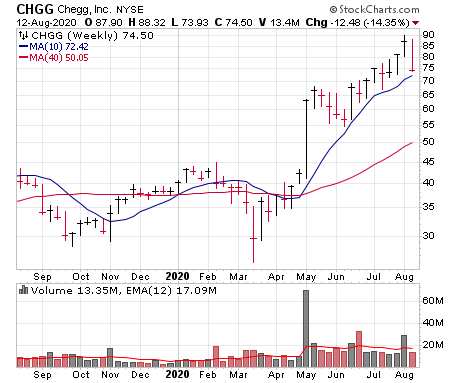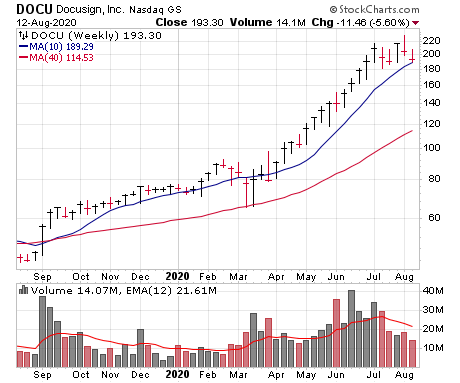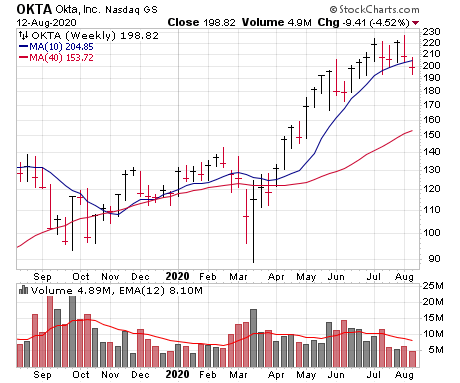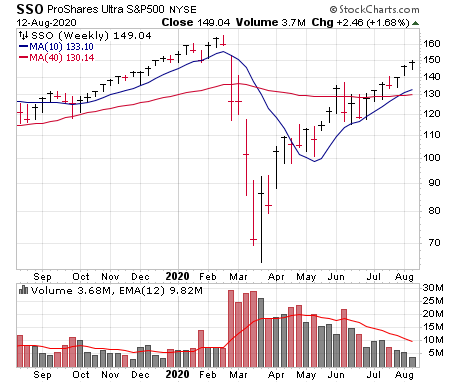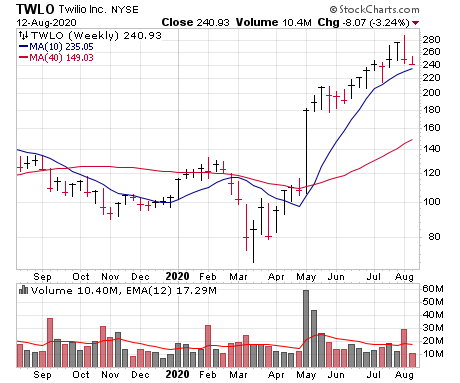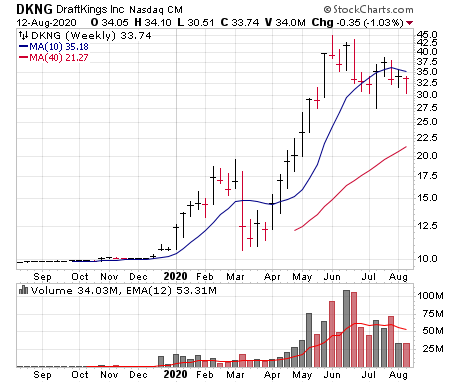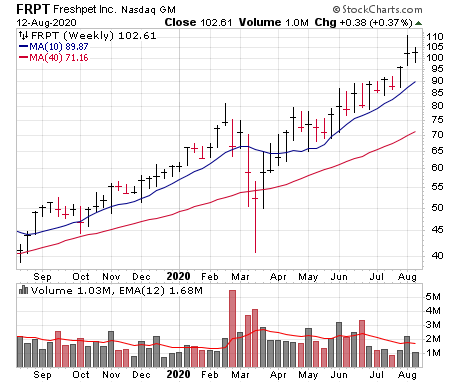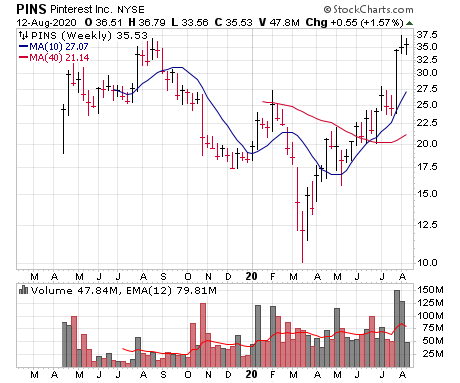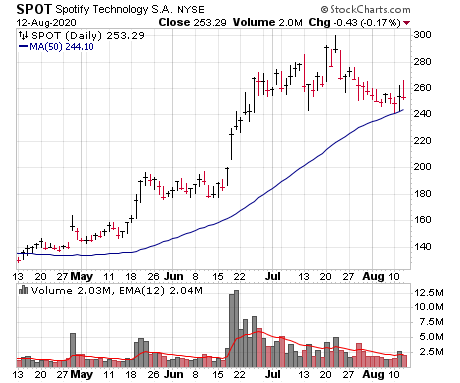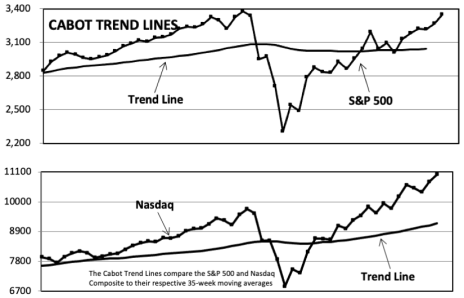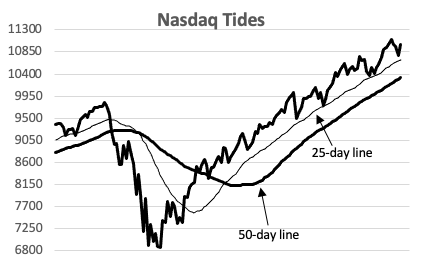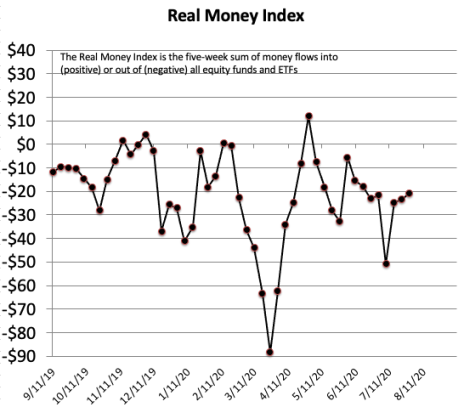The market remains in good shape, but growth stocks have come under pressure -- for the first time in months, we’re seeing a good amount of abnormal action. Longer-term, we’re still quite bullish, both on the market and on leading stocks, but given the action (and our solid gains this year), we’ve been paring back, with numerous partial profits and one outright sale, which has us holding a 37% cash position.
In tonight’s issue we write about all our latest thoughts on the market, and how to handle big winners that begin to act iffy. We also write up a handful of names we’re watching should growth stocks stabilize.
Cabot Growth Investor 1452
[premium_html_toc post_id="212260"]
Growth Stocks Under Pressure
We saw signs growth stocks were ready for a “real” correction in June, but the buyers showed up. And again in July, it appeared the red-hot growth titles were ready to rest—and some of them did—but most enjoyed yet another surge to record highs soon after. But now, after triple-digit gains in many stocks over the past four-plus months, we’ve finally seen a character change in the leaders.
Instead of big (often overwhelming) buying volume on the way up, many moved to new highs tepidly two weeks ago. Instead of one- or two-day dips, we’re seeing a consistent stream of selling over many days with a modest ability to bounce (though today was decent). And instead of nearly all finding support near logical levels, we’ve seen a good number of leaders crack key support (50-day lines, etc.), which itself a sign that big investors have changed.
Summed up, while everything pretty much went according to script from April through early August, we’re now seeing a good amount of abnormal intermediate-term action. Thus, we’ve been paring back, selling one stock outright and taking partial profits in three others; the Model Portfolio now holds 37% in cash.
Not all is dour, though. First off, notice we wrote that we’re seeing intermediate-term abnormal action—while a couple of stocks that have had extended runs could be done for, the vast majority we’re looking at (and all that we own) still are likely early-ish in their overall upmoves and aren’t being splattered on the floor.
Moreover, the suffering in growth stocks has actually benefited many other areas—rotation has helped some of the broader indexes (small and mid caps, etc.) perk up, keeping our trend-following indicators solidly bullish, while many secondary pieces of evidence (new lows, etc.) are also encouraging.
Thus, we’re not going to extrapolate the weakness in growth stocks (many of which ran higher while the broad market meandered in the spring) to the rest of the market; it’s always possible that happens, but there’s no sign of it yet. Instead, this simply looks like a case where, after a prolonged run, leading growth stocks are beginning well-deserved corrections.
How exactly you want to handle the wobbles is up to you (i.e., how much profit you’re willing to give up), but as usual, we prefer a middle ground—we’re never much in favor of holding and hoping things turn around, but throwing most of our stocks overboard isn’t advised, either. Hence, we’ve been taking things on a stock-by-stock basis, paring back when needed while keeping our eyes on fresh leadership that’s holding up well.
What To Do Now
After a great run, we think it’s time to lessen risk. Since last Friday, we’ve sold all of our Teladoc (TDOC) while selling one-third of our stakes in Twilio (TWLO), Cloudflare (NET) and Chegg (CHGG), leaving us with 37% in cash.
Model Portfolio Update
You knew it had to happen eventually. In the past week or two many leading stocks—a bunch of which have run 30% to 100% from their breakouts in April and May—have finally run out of steam, with more than a few flashing intermediate-term abnormal action. Since last Friday, we took the rest of our profit in Teladoc while booking partial profits in Cloudflare, Twilio and Chegg, leaving us with about 37% on the sideline.
All told, though, there are lots of bright spots still out there—the trends of the general market continue to look fine (if anything they’ve strengthened a bit due to the rotation into the broad market), and even among growth stocks, some names are holding up and we’ve even seen a few fresh names get going on earnings.
Still, given the evidence, we’re OK stepping a bit carefully to this point … but we’re also not overly anxious to sell wholesale, either, given the overall evidence and the fact that many stocks likely aren’t at long-lasting tops. We could start a half position in one of the names on our watch list if growth stocks find their footing, but we’ll stand pat tonight.
Current Recommendations
| Stock | No. of Shares | Portfolio Weightings | Price Bought | Date Bought | Price on 8/13/20 | Profit | Rating |
| Chegg (CHGG) | 1,600 | 6% | 65 | 5/22/20 | 77 | 19% | Hold |
| Cloudflare (NET) | 3,616 | 7% | 26 | 4/20/20 | 39 | 48% | Hold |
| Dexcom (DXCM) | 290 | 7% | 216 | 11/15/19 | 435 | 102% | Hold |
| DocuSign (DOCU) | 655 | 7% | 65 | 9/13/19 | 199 | 206% | Hold |
| Okta (OKTA) | 632 | 7% | 150 | 4/20/20 | 203 | 35% | Hold |
| ProShares Ultra S&P 500 (SSO) | 1,306 | 11% | 120 | 5/29/20 | 149 | 24% | Buy |
| Teladoc (TDOC) | — | — | — | — | — | — | Sold |
| Twilio (TWLO) | 553 | 7% | 174 | 5/8/20 | 244 | 40% | Hold |
| Wingstop (WING) | 1,313 | 11% | 128 | 6/19/20 | 157 | 23% | Buy |
| CASH | $658,580 | 37% |
Chegg (CHGG 77)—Bigger picture, we think Chegg has a very bright future, and that was confirmed by the Q2 report two weeks ago, which saw revenues accelerate wildly for its key services segment (up 53% vs. up 33% and 31% the prior two quarters), EBITDA grow even faster (up 79%) and, more importantly, had management talking very bullishly about a structural change in online education that should benefit the company for a long time to come. Combine all of that with CHGG being “only” three months into its latest move (breakout from a huge base at the start of May) and we think higher prices are likely down the road. However, we’re also running a portfolio, and like most leaders, CHGG is up huge during the past three months and, this week, has flashed some abnormal action, with a straight-down decline that gobbled up its recent gains before today’s bounce. Because of that, we took partial profits yesterday, selling one-third of our shares, and will follow our usual M.O. from here, giving our remaining position room to maneuver. SOLD ONE-THIRD, HOLD THE REST.
Cloudflare (NET 39)—Cloudflare’s Q2 was stronger than expected, with the top line (revenues rose 48%) looking good, various sub-metrics (637 customers now pay the firm six figures each year, up 65% from a year ago; same-customer revenue growth rate was at least 15% for the ninth straight quarter) impressing and the company even showed an operating profit. (Management also hiked guidance going forward.) Like many growth stocks, we think Cloudflare is likely to see years of solid growth, and given that it just got going earlier this year, we doubt the overall run is over. But given the recent weakness, we decided to take partial profits on Monday, selling one-third of our shares. Since then, NET has bounced off its 50-day line, which is a plus; we’ll be using a looser stop (low 30s) for our remaining position. SOLD ONE-THIRD, HOLD THE REST.
Dexcom (DXCM 435)—Growth stocks that had been sticking straight up in the air have nearly all taken big hits, but many that had already come down or had been consolidating for a while have held up better. DXCM is an example, with shares taking on some water but bouncing nicely off their 50-day line since and are currently perched just a few percent below all-time highs. And why not? The move toward continuous glucose monitors and away from old school techniques like finger sticks is still in the middle innings overall (and the early innings for certain patient populations like Type 2 diabetics), and Dexcom has the technological lead on the competition. Of course, we’re not complacent—a stop into the 350-360 area makes sense given that we’ve already taken some chips off the table here. But, while the short-term could see some further weakness, we continue to think the stock’s current three-month rest will eventually give way to higher prices. HOLD.
DocuSign (DOCU 199)—We’ve been on Hold for DOCU for a long time, thinking the stock was extended back in June. A few weeks later, the stock was solidly higher before it finally hit a speed bump in recent days. We all know the company’s growth story is pristine; not many firms can match DocuSign’s rapid, reliable growth profile. But the stock is not the company, so the real question is whether, after a run from its breakout level near 60 back in September of last year to a high of 230 last week, shares are going to need many months to rest, even if the bull market remains intact. As usual, we’ll let the stock tell its own story—so far, DOCU is actually testing its 10-week line for the first time during the post-crash upmove, which will usually bring in some support ... and so far, that’s been the case. If the selling pressures intensify, we could pare back or throw up a relatively tight mental stop for our remaining shares. Right now, though, we knew a correction was coming, so we’re happy to hold on and see if/when big investors step up to the plate. Earnings are likely out in early September. HOLD.
Okta (OKTA 203)—OKTA was one many growth stocks that tickled new highs last week but quickly fell down—and because it had been stalling out for a bit, it actually dipped below its 50-day line before bouncing. As with our normal plan, we took partial profits a few weeks ago and will give the rest of our shares some rope … though our leash isn’t limitless, especially as we’ve seen one new-age cybersecurity peer (CrowdStrike) break down and some others turn ragged. As with most of our stocks, our inclination is that OKTA’s next major move is up given all that’s going on (the CEO hinted that cloud adoption has accelerated years over the past few months), but having bought at 150, we don’t want to let too much of our profit evaporate. Thus, we’ll hold for now, but will throw up a mental stop near the stock’s June lows in the mid-170s. HOLD.
ProShares Ultra S&P 500 Fund (SSO 149)—Retired technician Walter Deemer says “the market gets most oversold at the bottom and most overbought at the beginning of a new advance” and that seems to be proving true again this time around—when we bought SSO after the 90% Blastoff Indicator flashed in late May, the market was extremely overbought, but as usual, that’s proven to be a bullish thing, with the S&P up around 12% since then. Near-term, SSO is stretched above support (its 50-day line is just above 133), so it wouldn’t shock us if the weakness in leading stocks spread to the rest of the market for a bit. But from a top-down perspective, both the primary (trend) and secondary (new lows, most sentiment measures) evidence remain positive, so until proven otherwise we think the path of least resistance remains up. BUY.
Teladoc (TDOC 192)—Two weeks ago Teladoc released one of the more impressive quarterly reports we can remember, bolstering hopes that, despite a big move already this year, the firm’s best-in-class virtual health offerings would keep big investors interested. Then came the acquisition of Livongo Health (LVGO), which changed perception—while Livongo is another rapidly growing outfit (it’s not like Teladoc bought some stodgy hospital), Teladoc certainly paid top dollar (LVGO was up from a breakout at 30 in March to a high of 150) and it muddied the previously clean growth story. Most important, big investors took the opportunity to cash in—TDOC went from a new high to below its 50-day line within one week on gigantic volume, and coming after a big run, that was enough for us to take the rest of our profit off the table. Long-term, TDOC could certainly set up again down the road; maybe institutions need to see a few months of progress and acquisition updates before diving back in. We’ll keep our eyes open, but near-term bounces aside, our guess is TDOC has topped for a while. SOLD.
Twilio (TWLO 244)—The combination of a good-not-great quarterly report, a large ($1.4 billion) share offering and the general downturn in growth stocks hasn’t been kind to Twilio; indeed, because of the big-volume reversal last week, we decided to book partial profits (selling one-third of our shares). Still, while we’re always flexible, at this point we’re willing to give the rest of our shares a lot of rope because of (a) the stock’s massive blastoff and run since May, and (b) due to its one-of-a-kind story—Twilio’s communications platform remains in great demand (total revenues up 46%; same-customer revenue growth of 32% in Q2) and there’s no reason to think the firm isn’t going to get much, much bigger as companies of all sizes sign up and increase their usage in order to automate communications (text, emails, voice, etc.) with customers and employees. Near-term, TWLO is probably still vulnerable, but shares remain north of their 50-day line (now near 233) even after this sharp drop, which is a plus. If you rung the register with us, sit tight with your remaining position. SOLD ONE-THIRD, HOLD THE REST.
Wingstop (WING 157)—WING has also pulled in of late, but to us this appears very normal—this isn’t a go-go stock, and after a big post-earnings rally, some steam was bound to be let off. Plus, it’s hard to ignore the massive-volume earnings move compared to the below-average dip of the past week. Of course, we won’t be whistling past the graveyard, either—we’re certainly not going to let all of our profit wither away, so a break into the low 130s (below the 50-day line, but above our cost of 128) would be a red flag. Still, we believe Wingstop is relatively rare merchandise both from a cookie-cutter perspective and because it stands to benefit no matter how economic re-openings go. Long story short, you should hold on if you own some, and if not, we’re game for picking up some shares here. BUY.
Watch List
- DraftKings (DKNG 36): DKNG has earnings tomorrow, and any decisive show of strength would be intriguing. See more below.
- PayPal (PYPL 193): PYPL looks completely fine—if anything, we’d prefer a longer/deeper pullback. The online spending story looks unstoppable, benefiting both from the new e-commerce reality and the economic rebound.
- Pinterest (PINS 35): PINS has the look and feel of a new glamour leader, thanks to the new e-commerce boom and from the fact that it’s new merchandise for big investors. See more later in this issue.
- Spotify (SPOT 254): SPOT has pulled back for four weeks and is trying to bounce off its 50-day line—completely normal action after a big run. See more later in this issue.
- Zillow (Z 74)/Redfin (RDFN 44): Both Z (which popped to new highs last week) and RDFN remain the most growth-y plays on the new housing boom.
Other Stocks of Interest
The stocks below may not be followed in Cabot Growth Investor on a regular basis. They’re intended to present you with ideas for additional investment beyond the Model Portfolio. For our current ratings on these stocks, see Updates on Other Stocks of Interest on the subscriber website or email mike@cabotwealth.com.
DraftKings (DKNG 36)—In the market, as in life, patience is a virtue; oftentimes it’s a matter of waiting for a stock with a great story to set up properly and begin a major advance. We wrote up DraftKings back in June, as it’s in pole position to lead the new wave of growth in the gaming sector, driven by online casinos (so-called iGaming), online sports betting and fantasy sports betting. The company’s history will give you an ice cream headache, as it was formed via some business combinations and divestitures, but the big idea here is straightforward: States are desperate for money, so more and more are approving various forms of the above types of gambling, and DraftKings is set to capture a good-sized chunk of the market thanks to a first-mover advantages, which include its strength in technology and marketing, as well as numerous partnerships. Just in the past month, it’s become PGA Tour’s first official betting operator, has expanded its fantasy sports offerings, launched sports betting (online and in person) with Casino Queen Sportsbook in Illinois and expanded an exclusive partnership with Major League Baseball. Obviously, as sports gradually reopen (with hiccups, of course), so will betting interest (analysts see nearly $500 million in revenue this year, with a 51% bump in 2021), but the prize here isn’t the near-term story—longer-term, as iGaming, online sports betting and fantasy sports betting grow, DraftKings sees a path to nearly $4 billion in revenue down the road with 25% cash flow margins. The stock topped out in early June, and while the pullback was sharp (39%), the 11-week rest since then has been completely normal given the giant prior advance. The company reports Q2 results tomorrow morning.
Freshpet (FRPT 106)—There’s a category of stocks we usually don’t traffic in much that we call “mutual fund” stocks; these are steady growth names that are very hard to hold on to (lots of chopping around, frequent corrections and dead periods), but that, because of their steady growth profile, tend to do well over time. (The name comes from the fact that big funds, who might own a small 2% position, can easily hold through all the nonsense.) Freshpet is one of those names, with a long-lasting story that’s easy to understand—it’s the leader in selling high-quality, vitamin- and protein-packed pet food that is specially prepared to retain more of the nutrients Pumpkin and Rocco need. Of course, it costs more, so it isn’t for everyone, but as pets have become an integral part of the family, more are willing to pay up; Freshpet says 3.5 million households are customers now, and expects that number to steadily rise to eight million by 2025. Throw in gradual price hikes, a growing e-commerce business (online sales tripled in Q2, though they make up just 5% of all sales) and a recession-resistant industry as a whole and you have a recipe for success—indeed, total sales in Q2 grew 33%, which accelerated from the usual high-20% pace before that, while EBITDA moved up nicely and analysts see the good times continuing (sales up 31% this year, 26% next, with profits expanding even quicker). As mentioned above, handling the stock has been tricky, though FRPT has acted nearly perfectly since the crash low, with a quick spike back to its highs in April, a steady rise along its 10-week line for a few months and, recently, a pop to all-time highs on good volume. It’s a bit extended here, but pullbacks would be tempting.
Meritage Homes (MTH 100)—Bigger picture, we remain very intrigued by housing, which (in terms of new construction) never really kicked into gear during the last economic expansion (still repairing after the bubble), but this time around might be different for three reasons: First, people are reassessing needs in the wake of the pandemic and social strife in big cities; second, there’s pent-up demand from those still renting; and third, the Fed is goosing the money supply and mortgage rates are crazy low. There are growthy plays in the sector (like Zillow (Z) and Redfin (RDFN), but a plain old homebuilder like Meritage looks like a decent bet, too. The company focuses on first-time, first time move-up and move-down buyers (giving it exposure both to the pent-up demand and as Baby Boomers retire) in many faster-growing areas (south east, Texas and parts of the western U.S.); all told, it’s the seventh largest builder in the country. And business is exploding! In Q2, not only did sales (up 19%) and earnings (up 82%) easily top estimates, but that actually understated Meritage’s strength—forward-looking total orders increased 32% from the year before and accelerated as the quarter went on, with April orders down 15%, May orders up 44% and June orders up a ridiculous 66% (!) from a year ago. And entry-level buyers were 70% of those orders, up from 51% a year ago. Even more important, management didn’t hold back for the second half of the year, hiking this year’s earnings expectations to $9 per share, up from around $6 before! The stock understandably looks great, with MTH having broken out a few weeks ago as it hovers near the century mark. Meritage isn’t changing the world, but it looks like a good, straightforward play on an improving economy. If cyclical-type stocks continue to gain steam, MTH could be one of the winners.
You Don’t Have to Make All or Nothing Decisions
Growth investing (and really any kind of stock investing) tends to be very skewed and streaky, with skewed meaning a relatively few trades will end up producing most of your profits, and streaky meaning that profits often come quickly but are followed by dead periods.
The skewed fact makes grabbing a few big winners over time key to overall performance. (Trust us—we tried in our formative years to make good money by cranking out a lot of small gains. It’s not easy to do, especially when you inevitably hit on a few losing trades in a row.) And that, in turn, means how you handle big winners is important … and that leads us to today’s environment.
Many huge growth stock winners from the post-March bottom have (finally) met with some persistent selling, with a few diving below key intermediate-term support. What should you do? Our experience is that many view it as an all or nothing decision—either hang on (or even buy more), or sell it all and move on.
There’s nothing “wrong” with that philosophy, but if you run a concentrated portfolio, you don’t have to make all or nothing decisions—when things get hairy and a deeper correction is possible, it’s fine to take partial profits and hold the rest. While it adds a little complexity, it has many advantages: First (of course), it allows you to book some profits. Second, it builds up a little cash in your portfolio, usually when things get dicey. And third, and maybe most important, it gives you more staying power with your remaining shares to hold on for what hopefully will be a much bigger move.
As for the details, it’s probably best to sell between one-quarter and one-half of your shares. If you’re only selling 10% of what you own, it’s hardly worth it; conversely, if you’re going to sell 70% or 80% of what you own, you might as well just get rid of it all. We usually settle on one-third of our shares as a meaningful, but not too large, portion to sell.
Over the years, we’d say we’ve taken some chips off the table on the way up with the majority of our big winners (and we’ve followed that path during the past week, too). That might raise the question “why sell any?” but in many cases, it’s the fact that we already had some profit booked that allowed us to sit through some harrowing retreats ... and that’s actually helped us hang on for a larger, longer-term move knowing we already have some profit in our back pocket.
The point here is that as much as we all want to predict the future, the market and leading stocks are uncertain; maybe some stocks really do top out completely right here, while others end up going much higher. Instead of making a series of all or nothing decisions, there’s nothing wrong with trimming and then seeing how things go in the days and weeks ahead.
Easiest to Spot Strength in a Weak Tape
As we just wrote, there’s plenty of uncertainty about what comes next for growth stocks, but one “good” thing (maybe the only good thing) about a down market for our kind of stocks is that the more resilient situations stick out like a sore thumb.
One name that’s caught our eye is Pinterest (PINS), a “visual discovery engine” (company’s words) that gives people ideas on everything from room redesigns to recipes. The stock benefits from both the structural changes going on with e-commerce these days, and from being new merchandise—it came public last April and just staged a huge liftoff after earnings three weeks ago. The driver: While revenues were up just 4% in Q2, management said ad spending on its site was up 50% in July, and while it guided more conservatively for Q3 as a whole, big investors seem to think Pinterest could be another one-of-a-kind platform for users and advertisers. PINS is on our watch list.
Another name that remains high on our list is Spotify (SPOT), which in our view, has acted normally during the past month as it’s pulled back following a monstrous run. To us, the firm reminds us of an early-stage Netflix, as it already has a dominant business in one area (music, where ad-supported and paid users are rising at 30%-ish rates), and is investing heavily in another big growth area (podcasts); losses are a fly in the story’s ointment, but as with Netflix, we think big investors will pay up for the firm’s top position, revenue growth and the likelihood of huge profits down the road. The stock’s test of its 50-day line (its first since blasting off) provides a temping entry point, though we’d like to see growth stocks find more support.
Cabot Market Timing Indicators
After a long, profitable run, the sellers have taken some growth stocks to the woodshed, though the market’s overall trends remain up and sentiment is modest. Given our focus on leading names, we’ve pared back further, but we’re not aiming to get overly cautious with the general market still acting well.
Cabot Trend Lines: Bullish
Our Cabot Trend Lines remain in great shape, with both indexes standing miles above their longer-term moving averages—at the end of last week, the S&P 500 was 9.8% above its 35-week line, while the Nasdaq was a whopping 19.7% above its own line. Clearly, those figures are extreme, and that fact may play along with the hesitation we’re seeing in some areas of the market. But there’s no question the big-picture trend remains up.
Cabot Tides: Bullish
While growth stocks are taking on water, our Cabot Tides are actually strengthening, as most of the major indexes perk up. Even the Nasdaq (daily chart shown here), home to most leaders that are taking on water, is still looking good as it holds north of its 25-day line. The growth stock weakness is something to pay attention to, but with the intermediate- and longer-term trends pointed up, we’re not getting overly cautious.
Cabot Real Money Index: Neutral
Our Real Money Index continues to gyrate in mostly neutral territory, as fund flows are negative on balance, but the five-week rate of change remains within its multi-month range. With the recent rotation, we’ll be looking to this indicator for any clues that investors are changing their views.
Charts courtesy of StockCharts.com
The next Cabot Growth Investor issue will be published on August 27, 2020.
Cabot Wealth Network
Publishing independent investment advice since 1970.
CEO & Chief Investment Strategist: Timothy Lutts
President & Publisher: Ed Coburn
176 North Street, PO Box 2049, Salem, MA 01970 USA
800-326-8826 | support@cabotwealth.com | CabotWealth.com
Copyright © 2020. All rights reserved. Copying or electronic transmission of this information is a violation of copyright law. For the protection of our subscribers, copyright violations will result in immediate termination of all subscriptions without refund. No Conflicts: Cabot Wealth Network exists to serve you, our readers. We derive 100% of our revenue, or close to it, from selling subscriptions to its publications. Neither Cabot Wealth Network nor our employees are compensated in any way by the companies whose stocks we recommend or providers of associated financial services. Disclaimer: Sources of information are believed to be reliable but they are not guaranteed to be complete or error-free. Recommendations, opinions or suggestions are given with the understanding that subscribers acting on information assume all risks involved. Buy/Sell Recommendations: All recommendations are made in regular issues or email alerts or updates and posted on the private subscriber web page. Performance: The performance of this portfolio is determined using the midpoint of the high and low on the day following the recommendation. Cabot’s policy is to sell any stock that shows a loss of 20% in a bull market or 15% in a bear market from the original purchase price, calculated using the current closing price. Subscribers should apply loss limits based on their own personal purchase prices.

